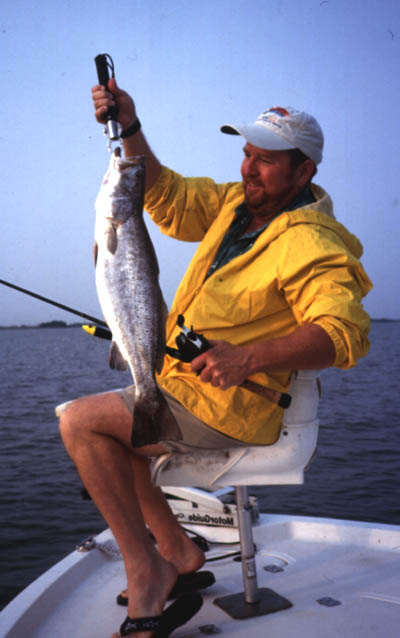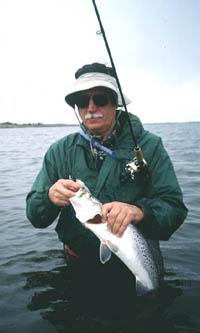
The Saltwater Magazine for Gulf Coast Fishing!
FISHING FORECASTS | FISHING CALENDARS | ARTICLES | ADVERTISE | SUBSCRIBE
Search Gulf Coast Fisherman's
Web Site
Past articles, specific
places or fish, etc.

East Galveston's
Big Trout Bonanza
by Robert Sloan

East Galveston Bay is among the most user friendly bays along the entire Texas coast for three very important reasons - there are plenty of big trout, finding the prime spots is easy and you can either wade of float your way to a big catch.
Over the years East Galveston Bay has proven itself to be a big trout producer during the winter months. That's remarkable seeing as how this bay gets so much angling pressure. It's within easy reach of Houston anglers that are well aware of the trophy trout potential of East Bay.
Jim West, with Bolivar Guide Service, has been putting anglers on big trout for over 30 years on East Bay.
"There is no doubt that this bay is special," says West. "Even though it gets a ton of fishing pressure, she keeps on producing big trout. One reason why is that so many anglers on this bay are into catch and release. There is no need to kill the big females. You can take a length and girth measurement and have a fiberglass replica made that looks great and last's a lot longer than a traditional skin mount."
Just about any good map of East Bay will detail the best places to fish. Some of those top spots are Hanna's Reef, West Bolivar Flats, Elmgrove Flats, Fat Rat Flats, Pepper Grove Reef, Robinson Flats, Cow Shed Reef, Smith Point and Northwest Flats.
"Wading is the best way to catch big cold water trout," says West. "You can drift fish in a boat, but being able to ease up on big trout by wading is the ticket."
Another option that a few anglers are tapping into is poling the shoreline. This is my favorite way to find and catch big trout. I fish out of a lightweight 17-foot Mitzi Skiff. It'll float in about 6 inches of water. When I'm on the tower I have the advantage of putting the angler on the bow in perfect position to fish any specific spot.
"Fishing a specific spot is important," says West, who over the years has caught his share of sow trout on East Bay. "I like to grind it out on little shell reefs. What I mean by that is I'll stand in one spot for hours while working lures over one area of shell. Quite often it's a matter of being there when the big trout decide to feed."
A classic example of being in the right spot at the right time occurred a few years back when West and I were wade fishing the lower tip of Hanna's Reef, located on the lower area of the bay. It was a cold day to be on the water. The wind was howling out of the north. We put in at Bolivar Bait Camp and ran up the Intracoastal Canal and turned into the bay. It looked like snow on the water.
"We've got a little bit of wind, and it's going to be a rough run but I think some big trout are going to be feeding on Hanna's," said West. "Hang on!"
The run was worth the punishment.
We anchored the boat, and waded down towards the lower tip of the reef. The wind was at our backs. West made a long cast with a slow sinking MirrOlure and hooked up.
"Big trout," he yelled.
I made a cast and let the green and white Catch 2000 MirrOlure settle down about 2 feet and clicked the bait casting reel into gear. The third time I picked up the rod tip to move the mullet-imitation lure slowly through the green water it stopped. I set the hook and a big sow came up shaking her head on the surface.
I looked over at West and he was letting a 7-pounder slide out of his hands. "We're on the tail end of an incoming tide," he said. "I don't know how long the bite is going to last. But one thing is certain - the big 'uns are here."
 Grinding it out on proven reefs is one way to catch
big East Bay trout. The best anglers on any given bay know that shell is
the key to finding trout. And on any given bay there are lots of small shell
reefs scattered from one end to the other. The most well known reefs get
the most pressure. The smaller ones quite often go unfished, even on weekends
and holidays when lots of anglers hit the water.
Grinding it out on proven reefs is one way to catch
big East Bay trout. The best anglers on any given bay know that shell is
the key to finding trout. And on any given bay there are lots of small shell
reefs scattered from one end to the other. The most well known reefs get
the most pressure. The smaller ones quite often go unfished, even on weekends
and holidays when lots of anglers hit the water.
I like to fish the reefs along the south shoreline of East Bay. That's where you'll find the most protected water, unless a front is moving in. In that situation the north shoreline is the best option.
The water on East Bay will "green up" nicely on a gentle southeast breeze. When the water gets clear you can see the big and small reefs. That's a good time to cover some water and mark the smaller reefs with a GPS, for future reference.
Another very good way to find the best and most secluded reefs on East Bay is to charter a plane and make some aerial photos or a video. The best time to do that is a day or two after a hard cold front has moved through. Combine that with a low tide and many of the reefs will be exposed. It's the quickest way to figure out any bay along the entire Gulf Coast.
My favorite way to catch big cold water trout on East Bay is to pole within a long cast of the small isolated reefs. I'm talking about a reef that's about the size of your living room. Of course you can wade those same reefs. But I'm into comfort, and being able to cast from the comfort of a shallow draft boat is the cat's meow.
When approaching a reef you want to stay just within casting range. Big trout are spooky by nature. The best way to fish a small reef is to work the outer edges first. If that doesn't produce work the lure over the top of the shell.
You never know how many big trout will be holding on and around a small reef. Sometimes there will be just one. But on other days you might find several on one small reef.
The best lures for big cold water trout are mullet imitation plugs. Wall class trout tend to feed exclusively on mullet and croaker. Most of the time, during periods of cold water, they will dine exclusively on mullet - big mullet. That's a full meal deal. So they won't be feeding all day long.
There is nothing finer than catching 5-pound-plus trout on a topwater plug. The big lures like a Super Spook or a MirrOlure She Dog or He Dog do a good job of imitating mullet on the surface. They have and side to side swimming action with a built in rattle chamber. And all three create quite a commotion on a slow but steady retrieve. And both have caught some mega-trout over the years. I used a chartreuse and black She Dog to catch a trout weighing just under 10 pounds this past spring.
The slow sinking mullet-imitations like a Corky or MirrOlure have accounted for lots of double-digit trout over the years. The slow-sinkers are not nearly as much fun to fish as a topwater, but they can produce when nothing else will. The key word when fishing slow sinking lures is slow. Keep in mind that the metabolism of a trout in cold water slows down significantly from that of summer. They aren't nearly as quick to eat a lure as you might believe. The idea is to put a lure in front of a hungry and trout and coax her into eating.
That's why a slow fished, soft-bodied Corky is so deadly on big trout. It's so slow to sink that it's almost like a suspending bait. The trick when fishing something like a Corky or a Catch 2000 is to keep the line tight enough to feel the lure as it's being worked through the water ever so slowly.
Cold water bites from big trout are not what you might think. Half the time you won't be able to feel them. Much of the time you'll just feel the lure stop. When in doubt set the hook.
The best time to be fishing a suspending bait is when the weather is ice cold. Conversely, the prime time to fish a topwater plug in cold water is when the sun is high and the water temperature is warming up a few degrees.
One of the best days of big trout fishing that I've ever had on East Bay was in January, about four days after a hard cold front had moved through. The wind had shifted to the southeast, the sun was high and warm and I was fishing up on Marsh Point Flats, out of Stingaree Marina. I was slow poling my skiff from reef to reef in about 3 feet of water. I staked the boat out and made a long cast to a pod of shell that wasn't any bigger than a pickup truck. I had made about three cranks on the reel handle and an arm length trout swirled and ate the bone colored Super Spook Jr. That one weighed about 7-1/2 pounds. I was in the right place at the right time. The big trout along that reef really came to life. And they were more than willing to hammer a topwater lure.
The best place to put in on the lower end of East Bay is at Bolivar Bait Camp. On the upper end use the ramps at Stingaree Marina.
You can set up a fishing trip with Jim West at 409-684-7162.
For information on fishing with Robert Sloan send an email to sloan288@aol.com. isolated reefs. I'm talking about a reef that's about the size of your living room. Of course you can wade those same reefs. But I'm into comfort, and being able to cast from the comfort of a shallow draft boat is the cat's meow.

